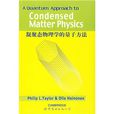《凝聚態物理學的量子方法》是2003年世界圖書出版公司出版的圖書,作者是Philip L.Taylorand Olle Heinonen。
基本介紹
內容簡介
圖書目錄
Chapter 1 Semiclassical introduction
1.1 Elementary excitations
1.2 Phonons
1.3 Solitons
1.4 Magnons
1.5 Plasmons
1.6 Electron quasiparticles
1.7 The electron-phonon interaction
1.8 The quantum Hall effect
Chapter 2 Second quantization and the electron gas
2.1 A single electron
2.2 Occupation numbers
2.3 Second quantization for fermions
2.4 The electron gas and the Hartree-Fock approximation
2.5 Perturbation theory
2.6 The density operator
2.7 The random phase approximation and screening
2.8 Spin waves in the electron gas
Chapter 3 Boson systems
3.1 Second quantization for bosons
3.2 The harmonic oscillator
3.3 Quantum statistics at finite temperatures
3.4 Bogoliubov''s theory of helium
3.5 Phonons in one dimension
3.6 Phonons in three dimensions
3.7 Acoustic and optical modes
3.8 Densities of states and the Debye model
3.9 Phonon interactions
3.10 Magnetic moments and spin
3.11 Magnons
Chapter 4 One-electron theory
4.1 Bloch electrons
4.2 Metals, insulators, and semiconductors
4.3 Nearly free electrons
4.4 Core states and the pseudopotential
4.5 Exact calculations, relativistic effects, and the structure factor
4.6 Dynamics of Bloch electrons
4.7 Scattering by impurities
4.8 Quasicrystals and glasses
Chapter 5 Density functional theory
5.1 The Hohenberg-Kohn theorem
5.2 The Kohn-Sham formulation
5.3 The local density approximation
5.4 Electronic structure calculations
5.5 The Generalized Gradient Approximation
5.6 More acronyms: TDDFT, CDFT, and EDFT
Chapter 6 Electron-phonon interactions
6.1 The Frohlich Hamiltonian
6.2 Phonon frequencies and the Kohn anomaly
6.3 The Peierls transition
6.4 Polarons and mass enhancement
6.5 The attractive interaction between electrons
6.6 The Nakajima Hamiltonian
Chapter 7 Superconductivity
7.1 The superconducting state
7.2 The BCS Hamiltonian
7.3 The Bogoliubov-Valatin transformation
7.4 The ground-state wave function and the energy gap
7.5 The transition temperature
7.6 Ultrasonic attenuation
7.7 The Meissner effect
7.8 Tunneling experiments
7.9 Flux quantization and the Josephson effect
7.10 The Ginzburg-Landau equations
7.11 High-temperature superconductivity
Chapter 8 Semiclassical theory of conductivity in metals
8.1 The Boltzmann equation
8.2 Calculating the conductivity of metals
8.3 Effects in magnetic fields
8.4 Inelastic scattering and the temperature dependence of resistivity
8.5 Thermal conductivity in metals
8.6 Thermoelectric effects
Chapter 9 Mesoscopic physics
9.1 Conductance quantization in quantum point contacts
9.2 Multi-terminal devices: the Landauer-Buttiker formalism
9.3 Noise in two-terminal systems
9.4 Weak localization
9.5 Coulomb blockade
Chapter 10 The quantum Hall effect
10.1 Quantized resistance and dissipationless transport
10.2 Two-dimensional electron gas and the integer quantum Hall effect
10.3 Edge states
10.4 The fractional quantum Hall effect
10.5 Quasiparticle excitations from the Laughlin state
10.6 Collective excitations above the Laughlin state
10.7 Spins
10.8 Composite fermions
Chapter 11 The Kondo effect and heavy fermions
11.1 Metals and magnetic impurities
11.2 The resistance minimum and the Kondo effect
11.3 Low-temperature limit of the Kondo problem
11.4 Heavy fermions
Bibliography
Index

